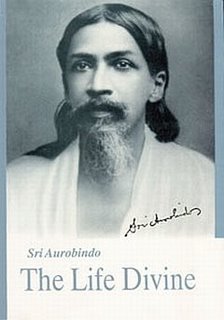 |
Matter
Divinity in Matter
In our zeal of exploring the unlimited potentialities of the mind and the voluptuous outpouring of Life, we tend to disregard the body which seems to be limited by in-built restrictions of Matter. Yet the principle of Matter represented in the human body is the foundation on which Life finds its habitat and in turn supports the emergence of Mind. Sri Aurobindo cautions that the human body not only supports an evolutionary form that surpasses other species but also could also evolve to produce a qualitatively superior body that would support the emergence of higher powers of consciousness surpassing the present mental cognition. “The importance of the body is obvious; it is because he has developed or given a body and brain capable of receiving and serving a progressive mental illumination that man has risen above the animal. Equally, it can only be by developing a body or at least a functioning of the physical instrument capable of receiving and serving a still higher illumination that he will rise above himself and realise, not merely in thought and in his internal being but in life, a perfectly divine manhood”. (The Life Divine, pg.246) This is of immense metaphysical importance. If the present body that supports an imperfect Life and Mind is the final culmination of the evolutionary process, the only way to attain the Absolute or Sachchidananda would be to abandon mind, life and body to be absorbed into the Void. Only if the body evolves to support a divine manhood can there be a chance to realize Sachchidananda without cancelling Life and Mind.
|
|
Unfortunately, the body has been singled out traditionally as the soul’s chief obstacle. It is ironical that the “world-disgust” of the spiritual seeker selects the body as the only “world-principle” from which deliverance should be sought to justify an ascetic retreat. (Ibid, pg.247) However, traditions older than the conventional religions were more pragmatic not to make this formidable separation; “they acknowledged Earth the Mother and Heaven the Father and accorded to them an equal love and reverence”. (Ibid) This is beautifully expressed in the reverence to Matter through the tradition of earth-altars in ancient India and China. Even today, many Indian households have an earth-altar in the courtyard growing the Tulasi or Holy Basil plant. It is also known how Matter was invested with Divine qualities through the veneration of stones. If Shiva could be portrayed through a bare stone symbolizing that Truth is naked, the holiest sanctuary in Islam is the Ka’aba or the black stone in Mecca while in Christian symbolism , Christ is “the stone that builders rejected” which became “the head of the corner” [LukeXX:17]. (Jung, Carl (Conceived & Edited): Man and his Symbols, Picador, 1964, UK, pg.225)
One of the earliest examples of how Matter was invested with divinity is Jacob’s dream in the Old Testament:
“And Jacob …went towards Haran. And he lighted upon a certain place, and tarried there all night, because the sun was set; and he took of the stones of the place, and put them for his pillows and lay down in that place to sleep. And he dreamed, and behold a ladder set up on the earth, and the top of it reached to heaven, and behold the angels of God ascending and descending on it. And, behold, the Lord stood above it, and said, I am the Lord God of Abraham thy father, and the god of Isaac: the land whereon thou liest, to thee will I give it, and to thy seed.
And Jacob awaked out of his sleep, and he said, surely the Lord is in this place; and I know it not. And he was afraid, and said, how dreadful is this place! This is none other but the house of God , and this is the gate of heaven. And Jacob rose up early in the morning and took the stone he had put for his pillows, and set it up for a pillar, and poured oil on the top of it. And he called the name of that place Beth-el.” (Ibid, pg.258-259)
Thus, Matter represented in the stone became an important link in the revelation –a mediator between the human being and God. Sri Aurobindo laments that such ancient mysteries have become “obscure and unfathomable to our gaze who, whether our view of things be materialistic or spiritual, are alike content to cut the Gordian knot of the problem of existence with one decisive blow..” (The Life Divine, pg.247)
Date of Update:
23-Sep-19
- By Dr. Soumitra Basu
|

